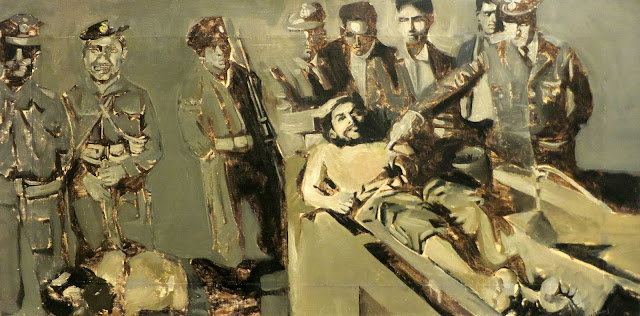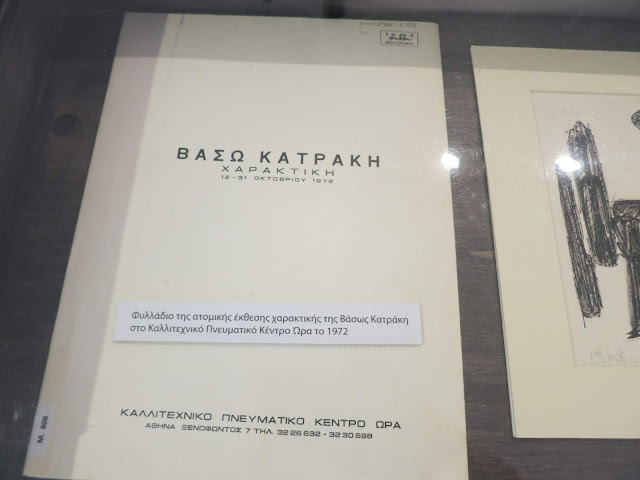Resistance - Art in the Dark Years, 1967-1974, at the Contemporary Greek Art Institute, Athens.
Dark years indeed, one of the worst periods in Greek history. On April 21, 1967, a group of right-wing army officers seized power in a coup d'état. This was a result of a culmination of 30 years of national division between the forces of the left and the right that can be traced back to the time of the resistance against the Axis occupation during WWII, which was followed by a civil war fought between the communist forces and the now-returned government-in-exile. The coup was aided by the British government, which under the prime ministership of Winston Church was determined to half the Soviet encroachment in the Balkans, and by the United States which, under the Truman Doctrine, had began to actively support a series of authoritarian governments in Greece, Turkey and Iran.
The colonels were able to seize power quickly by using elements of surprise and confusion. Tanks were placed in strategic positions in Athens, effectively gaining complete control over the city. At the same time, a large number of small mobile units were dispatched to arrest leading politicians and ordinary citizens suspected of left-wing sympathies according to lists prepared in advance.
By the early morning hours the whole of Greece was in the hands of the colonels. One of the most vivid memories of my teenage years is waking up in the morning, getting ready for school. I left the house, and I remember standing in the garden, surrounded by this eerie silence. A passer-by, the only person around, who saw me standing there, said to me that I needed to go inside and stay inside, as I would not be able to leave the house that day. And this is what I did. We stayed indoors for a few days. The coup d'état was announced over Greek radio, martial music was continuously broadcast, interrupted from time to time with announcements of the junta issuing orders, which always started with the introduction 'we decide and we order'. Political freedoms and civil liberties, which up to then had been taken for granted, were suppressed. Democracy had been dismantled. Freedom of thought and freedom of the press were suspended. Torture became a deliberate practice carried out by both the Security Police and the Greek military police, with an estimated 3,500 people detained in torture centres. Commonly used methods of torture included, but were not limited, to: beating the soles of the feet, sexual torture, choking and ripping out body hair, continuous standing in an empty room, sleep and food deprivation, beatings and loud sounds.
According to a human rights report by Amnesty International, in the first month of the coup, an estimated 8,000 people were arrested. A psychology of fear pervaded. Surveillance of citizens was a fact of life, even during the few permitted social activities. Photography was banned in public locations. The country had become a true police state.
Seven years later, the collapse of the junta was triggered by a series of events, the pressure of the Turkish invasion of Cyprus being the catalyst.
The works of art in this exhibition were created during those dark years, some are overtly political, some covertly. Many were produced abroad.
Vlassis Kaniaris, Red carnation, 1969
A. Tassos, The Torture and Death of Electra Apostolou, 1967

Vangelis Dimitreas, Demonstration, 1968 (ink on paper)
Asandour Baharian, The Prison in Kerkyra, 1972
Kyriakos Kantzourakis, Che, 1968, (oil on canvas)
Kyriakos Kantzourakis, The Exception, 1968, (oil on canvas)
Cleopatra Digga, Mirror, 1972 (acrylic)

Leda Papakonstantinou, Hello, How Are You? Are You Well?, 1974
Photograph of Leda Papakonstantinou with the sculpture
Vasso Kyriaki, Vietnam, 1968, (collage and acrylic)
Yannis Yaitis, Che Guevara's Funeral, 1968, (oil on canvas)
Demosthenes Skoulakis, Days of 1967, 1970, (oil on canvas)
Vasso Katraki, Antigone's Debt, 1972
Demosthenes Kokkinidis, Mother and Child, 1968-69, (acrylic on fabric)
Vasso Katraki, Remembering Panagiotis Elis, (engraving on stone)

Cleopatra Digga, Politicians, 1972

Yiannis Valavanides, Untitled, 1973, (tempera on paper)
Vasso Katraki, Pebbles painting while on exile, Gioura, 1967
During the junta years political prisoners were incarcerated in concentration camps on arid islands where some were kept there for years: this is most commonly referred to as exile. Makronisos is the most infamous one. Vasso Katraki was arrested on the first day of the coup. She spent nine and half months there, suffering hunger, thirst and beatings. She was a life-long resistance fighter, and was also involved in the National Liberation Front (EAM) resistance movement opposed to the German occupiers of Greece during WWII.
Vasso Katraki, etching created while she was in exile in Gioura
Vasso Katraki, etching created while she was in exile in Gioura
Vourvoula Skoura, record sleeve of Mikis Theodorakis' double album 'Theodorakis directs Theodorakis' 1971-73
The lyrics of Antonito El Camborio, by Frederico Garcia Lorca, one of my favourite Theodorakis songs, so I have downloaded it on YouTube, sang by Maria Farantouri.
Theodorakis left Greece during the junta, as did Maria Farantouri. They went to Paris where they worked, produced albums and went on world tours, sending a very strong political message against the junta. Theodorakis' music gave those of us, who were in Greece, hope and courage. We used to go to night clubs, called boites at the time, clandestine places, where we would listen to live renditions of his music - one of the few forms of resistance for many people.























No comments:
Post a Comment